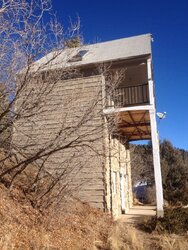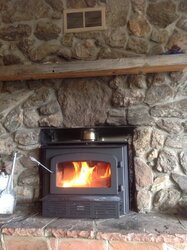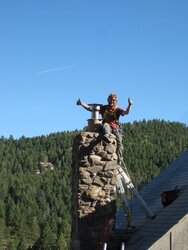Hello! New to the forums and need some advice. I just recently installed a Drolet Escape insert in my new (to me) home in Conifer, Colorado. My installation includes 17 feet of insulated flex liner and an insulated block off plate above the stove.
My home has an unusual layout... 1410 square feet and 3 levels, each level being 470 square feet with an open stairwell running down the center rear of the house. The top floor is the kitchen/living area to take advantage of the mountain views. This is where the stove is located. The middle floor is where the two bedrooms and bathroom are located. A rec room and the laundry/furnace room are located on the bottom floor. Both the middle and bottom floor are almost completely bermed underground.

With the stove located on the top floor of the house, this area easily gets too hot. I need some advice on how to distribute some of his heat to the lower levels of the house.

Three feet above the stove is an existing 6" duct that runs down to the bottom floor and is tied into the return air of the furnace. However, when the furnace is running hardly any air is being sucked through this duct because there is a much, much larger return air duct located close to the furnace at the very bottom of the stairwell. My thought is to disconnect the small 6" duct from the furnace and install some sort of inline fan. The fan will either blow cool air up to the stove room or suck warm air down to the lower level. The end of the duct at the bottom level will either tie into the existing furnace warm air ducts or simply have a grille at the bottom of the stairwell. Before installing the insert I ran a pair of wires down the old ash clean out to the lower level with the idea of installing some sort of snap disk thermostat to only run the fan when the stove is hot.
So now I need some advice....blow cool air up or suck warm air down. What size fan (cfm)? Will any of this work or am I stuck with an overheated upper level. And yes....I am concerned about safety.
Thanks in advance for any insight,
Guenther

My home has an unusual layout... 1410 square feet and 3 levels, each level being 470 square feet with an open stairwell running down the center rear of the house. The top floor is the kitchen/living area to take advantage of the mountain views. This is where the stove is located. The middle floor is where the two bedrooms and bathroom are located. A rec room and the laundry/furnace room are located on the bottom floor. Both the middle and bottom floor are almost completely bermed underground.

With the stove located on the top floor of the house, this area easily gets too hot. I need some advice on how to distribute some of his heat to the lower levels of the house.

Three feet above the stove is an existing 6" duct that runs down to the bottom floor and is tied into the return air of the furnace. However, when the furnace is running hardly any air is being sucked through this duct because there is a much, much larger return air duct located close to the furnace at the very bottom of the stairwell. My thought is to disconnect the small 6" duct from the furnace and install some sort of inline fan. The fan will either blow cool air up to the stove room or suck warm air down to the lower level. The end of the duct at the bottom level will either tie into the existing furnace warm air ducts or simply have a grille at the bottom of the stairwell. Before installing the insert I ran a pair of wires down the old ash clean out to the lower level with the idea of installing some sort of snap disk thermostat to only run the fan when the stove is hot.
So now I need some advice....blow cool air up or suck warm air down. What size fan (cfm)? Will any of this work or am I stuck with an overheated upper level. And yes....I am concerned about safety.

Thanks in advance for any insight,
Guenther



